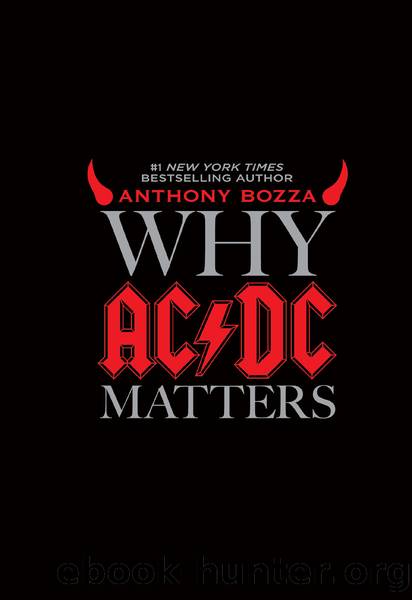Why ACDC Matters by Anthony Bozza

Author:Anthony Bozza
Language: eng
Format: epub
Publisher: HarperCollins
Published: 2009-01-15T00:00:00+00:00
AC/DC probably have one of the best rhythm sections of all time. The only time that AC/DC ever sucked was during the period when Phil Rudd left the band. He is the perfect fit for the AC/DC sound.
âSlash
Philip Hugh Norman Witschke Redzevcuts, born in Melbourne in 1954, is the only long-standing member of AC/DC to be born in Australia. He started to play drums in high school, though his family neither supported nor encouraged it. Phil dropped out of school at fifteen, began an apprenticeship with an electrician, and, once heâd earned some money, bought himself a drum kit. He says that he took exactly one formal lesson, opting instead to play along to recordings of his heroes and learn on the fly, sitting close enough to his speakers that he could hear the records over the sound of his own drums. His âteachersâ were all classic, solid stylists: Simon Kirke of Free and Bad Company, Corky Laing of Mountain, Ringo Starr of the Beatles, and Kenny Jones of the Small Faces.
It didnât take him long to start playing in local bands. In 1972, he joined Mad Mole, a band that played by-the-numbers blues rock, as well as Krayne, a more progressive trio closer in spirit to Uriah Heep and Deep Purple that featured a friend of his from school, Geordie Leach, on bass. Rudd left both bands to join Charlemagne who stayed together about a year and played nothing but Humble Pie, Small Faces, and Free covers in bars and at parties. In 1973, Rudd and Geordie Leach resumed playing together and got more serious about their endeavors. They dubbed their new band Smack, and after rehearsing together for a few weeks they began inviting singers to join them. They found their front man the moment Gary âAngryâ Anderson walked in, and they signed him up on the spot. Andersonâs raspy voice and tough-as-nails persona are legendary in Australian rock: he and Leach would later form the iconic Aussie band Rose Tattoo, of whom AC/DC were early supporters. From 1978 through 1984. Rose Tattooâs first four albums were produced by George Young and Harry Vanda, and, though they were never widely embraced in the United States, they were a tremendous influence on the nascent L.A. metal scene that spawned Mötley Crüe, Guns Nâ Roses, Faster Pussycat, Ratt, and many more. âRose Tattoo was great when they played here in L.A. in the early â80sâjust totally kick-ass, wearing all this leather,â says Tommy Lee, drummer for Mötley Crüe. âAngry Anderson was the first guy that we ever saw who had full sleeve tattoos like that.â
But first came Smack, who assiduously renamed themselves Buster Brown and set about playing bars, covering the Rolling Stones, the Faces, Elton John, Stevie Wonder, Eric Clapton, and everyone else with a hard blues backbeat. They got onto the bill at the Sunbury Pop Festival in 1974, an outdoor event that boasted an attendance of thirty thousand people, and went over so well that the crowd called them back for two encores.
Download
This site does not store any files on its server. We only index and link to content provided by other sites. Please contact the content providers to delete copyright contents if any and email us, we'll remove relevant links or contents immediately.
The Goal (Off-Campus #4) by Elle Kennedy(13541)
Kathy Andrews Collection by Kathy Andrews(11726)
Diary of a Player by Brad Paisley(7487)
What Does This Button Do? by Bruce Dickinson(6133)
Assassin’s Fate by Robin Hobb(6123)
Big Little Lies by Liane Moriarty(5697)
Altered Sensations by David Pantalony(5043)
Pale Blue Dot by Carl Sagan(4906)
Sticky Fingers by Joe Hagan(4100)
The Death of the Heart by Elizabeth Bowen(3550)
The Heroin Diaries by Nikki Sixx(3492)
Beneath These Shadows by Meghan March(3261)
Confessions of a Video Vixen by Karrine Steffans(3240)
How Music Works by David Byrne(3182)
The Help by Kathryn Stockett(3082)
Jam by Jam (epub)(3019)
Harry Potter 4 - Harry Potter and The Goblet of Fire by J.K.Rowling(2984)
Strange Fascination: David Bowie: The Definitive Story by David Buckley(2797)
Petty: The Biography by Warren Zanes(2696)
